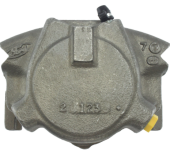- Joined
- Jul 21, 2006
- Messages
- 2,756
Trying to troubleshoot the T-Bird calipers on my 77. They SUCK, but why?
Running T-Bird up front, Explorer discs in back, 1-1/8 MC and WH Hydroboost.
2500 psi @ MC
1500 psi @ transition from hard line to caliper flex with one caliper disconnected. (note this it not at the tee above the diff but at the junction near the coil spring bucket.
500 psi @ caliper bleeder
Tried bleeding with caliper off knuckle and bleeder at 12 o'clock to ensure no air = still 500 psi
Soft line not kinked.
What are my potential culprits here? No much left but flex line, banjo and caliper.
Considered a partial blockage in the line, but that should eventually yield more than 500 psi with repeated pumps, no?
This setup has NEVER worked well in the 10 years I've been running it but I've finally had enough and willing to figure it out.
FWIW- This setup is NOT from a vendor. They are off the shelf parts so I milled the calipers for the banjo and drilled the banjo for the fitting.
EDIT: Summary to date: With a NEW caliper sitting on the inner fender inches from the MC with steel plates sandwiched inside (no pads), connected DIRECTLY to a NEW MC via a NEW hose and a 10" hard line, it yields 500psi, a loss of 2000psi!
Running T-Bird up front, Explorer discs in back, 1-1/8 MC and WH Hydroboost.
2500 psi @ MC
1500 psi @ transition from hard line to caliper flex with one caliper disconnected. (note this it not at the tee above the diff but at the junction near the coil spring bucket.
500 psi @ caliper bleeder
Tried bleeding with caliper off knuckle and bleeder at 12 o'clock to ensure no air = still 500 psi
Soft line not kinked.
What are my potential culprits here? No much left but flex line, banjo and caliper.
Considered a partial blockage in the line, but that should eventually yield more than 500 psi with repeated pumps, no?
This setup has NEVER worked well in the 10 years I've been running it but I've finally had enough and willing to figure it out.
FWIW- This setup is NOT from a vendor. They are off the shelf parts so I milled the calipers for the banjo and drilled the banjo for the fitting.
EDIT: Summary to date: With a NEW caliper sitting on the inner fender inches from the MC with steel plates sandwiched inside (no pads), connected DIRECTLY to a NEW MC via a NEW hose and a 10" hard line, it yields 500psi, a loss of 2000psi!
Last edited:











